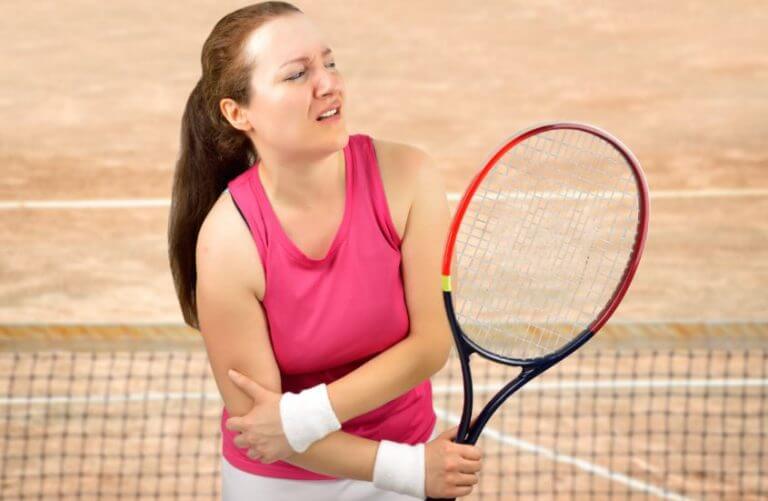Sports Injuries and the Rehabilitation Stages

In the following article, we’ll dive deep into the world of sports injuries and the subsequent rehabilitation process. To do this, it’s essential to understand what injuries consist of and the stages that athletes must go through during the recovery period. It’s also a good idea to be aware of the negative consequences that injuries may have on them.
Sports injuries
Sports injuries have a great significance in this context because they cause a certain period of inactivity with multiple adverse consequences for the athlete. These effects can be more or less harmful. It all depends on how serious the injury is, the moment at which they occur and their evolution.
Injuries are an undesirable and unavoidable component of practicing sports. When athletes suffer an injury, they must stay away from training and competitions during varying periods of time.
This sudden change can cause negative physiological consequences. It translates to partially or completely losing the adaptations that the athlete gained through exercise. This means that injuries directly impact their sports performance.
What do we mean by sports injuries?
There’s no single and universal definition for this concept. Most definitions come from a medical-therapeutic perspective. However, the definition that fits better in the field of sports science is the one from Lalín (2008):
“An injury is a type of body damage that affects the well-being of the subject. It’s caused by a direct or indirect mechanism in an anatomic area. This damage affects the person chronically or severely, and it keeps them away from performing physical sports activities during a period of at least 24 hours. Therefore, it can cause deterioration of their functional capacity, their physical competence or end their sport life”.

Factors that predispose athletes to suffer injuries
According to Shrier (2007), the causes that we consider to be a necessary condition for injuries can be very diverse. Therefore, this is a multifactorial risk. We can still divide it into different factors that produce a greater predisposition and susceptibility for injuries in the athlete:
- Skill level
- Game surface characteristics
- The subject’s attitude, posture and unbalances
- Inappropriate warm-up
- Poor proprioceptive ability
- Inadequate levels of muscle strength
- Lack of flexibility work
- Insufficient or inadequate recovery
- Habits and lifestyle
Rehabilitation after sport injuries
Now that we’ve explained and understood the concept of sports injuries and the negative consequences they have on athletes, we can go deeper into the importance of reducing the inactivity period to the minimum. A period known as rehabilitation begins after the injury.
Rehabilitation is the general process through which the medical, therapeutic and physical team reestablish, develop, improve and optimize the functionality and physical condition of the injured athlete. The purpose of this work is ensuring that the athlete reincorporates his sports activities easily and as soon as possible.
One of the characteristics of this process is that it must be faced from different perspectives. Therefore, the most important thing is to have a multidisciplinary team in which the doctor, physical therapist and trainer contribute in a coordinated way.
Fields of professional activity
Lalín (2008) establishes that there are two functional fields of professional activity:
- Functional sports recovery: refers to the process through which a clinical professional heals the injured structure so that it recovers its normal function. During this stage, most of the responsibility falls on the healthcare professional.
- Physical sports rehabilitation: in this stage, the athlete must re-train their physical condition to reestablish and improve physical patters and motors.
Stages of the physical sports rehabilitation process
This process must have different stages within its structure to clearly define the goals and specific contents in each stage. The author we mentioned before (Lalín, 2008), establishes the following breakdown of the stages:
- Approximation or functional recovery: the goal is to maintain the basic levels of physical condition in the structures that weren’t affected by the injury. It’s also important to avoid the total loss of functionality in the injured body part.
- Orientation or physical rehabilitation: this stage is about strengthening the injured area and improving the levels of physical condition in general.

- Preoptimization or retraining: the purpose of this stage consists of reeducating the specific motor patterns in the sports modality while having the athlete’s needs in mind.
- Optimization or specific training: the goal is to train specifically for the required sport modality.
It’s important to keep in mind that, no matter which type of rehabilitating program you choose, you must establish the goals and contents based on scientific criteria. Therefore, the program must have the correct design and include adequate exercises that are specific to the injury that you want to treat.
In conclusion, the most important aspect to have a successful rehabilitation is to consider all of the stages, goals, and contents that complete this process. It’s important to think about the athlete as a unique individual, use common sense in every step of the recovery and not leave any aspect of it to chance.
In the following article, we’ll dive deep into the world of sports injuries and the subsequent rehabilitation process. To do this, it’s essential to understand what injuries consist of and the stages that athletes must go through during the recovery period. It’s also a good idea to be aware of the negative consequences that injuries may have on them.
Sports injuries
Sports injuries have a great significance in this context because they cause a certain period of inactivity with multiple adverse consequences for the athlete. These effects can be more or less harmful. It all depends on how serious the injury is, the moment at which they occur and their evolution.
Injuries are an undesirable and unavoidable component of practicing sports. When athletes suffer an injury, they must stay away from training and competitions during varying periods of time.
This sudden change can cause negative physiological consequences. It translates to partially or completely losing the adaptations that the athlete gained through exercise. This means that injuries directly impact their sports performance.
What do we mean by sports injuries?
There’s no single and universal definition for this concept. Most definitions come from a medical-therapeutic perspective. However, the definition that fits better in the field of sports science is the one from Lalín (2008):
“An injury is a type of body damage that affects the well-being of the subject. It’s caused by a direct or indirect mechanism in an anatomic area. This damage affects the person chronically or severely, and it keeps them away from performing physical sports activities during a period of at least 24 hours. Therefore, it can cause deterioration of their functional capacity, their physical competence or end their sport life”.

Factors that predispose athletes to suffer injuries
According to Shrier (2007), the causes that we consider to be a necessary condition for injuries can be very diverse. Therefore, this is a multifactorial risk. We can still divide it into different factors that produce a greater predisposition and susceptibility for injuries in the athlete:
- Skill level
- Game surface characteristics
- The subject’s attitude, posture and unbalances
- Inappropriate warm-up
- Poor proprioceptive ability
- Inadequate levels of muscle strength
- Lack of flexibility work
- Insufficient or inadequate recovery
- Habits and lifestyle
Rehabilitation after sport injuries
Now that we’ve explained and understood the concept of sports injuries and the negative consequences they have on athletes, we can go deeper into the importance of reducing the inactivity period to the minimum. A period known as rehabilitation begins after the injury.
Rehabilitation is the general process through which the medical, therapeutic and physical team reestablish, develop, improve and optimize the functionality and physical condition of the injured athlete. The purpose of this work is ensuring that the athlete reincorporates his sports activities easily and as soon as possible.
One of the characteristics of this process is that it must be faced from different perspectives. Therefore, the most important thing is to have a multidisciplinary team in which the doctor, physical therapist and trainer contribute in a coordinated way.
Fields of professional activity
Lalín (2008) establishes that there are two functional fields of professional activity:
- Functional sports recovery: refers to the process through which a clinical professional heals the injured structure so that it recovers its normal function. During this stage, most of the responsibility falls on the healthcare professional.
- Physical sports rehabilitation: in this stage, the athlete must re-train their physical condition to reestablish and improve physical patters and motors.
Stages of the physical sports rehabilitation process
This process must have different stages within its structure to clearly define the goals and specific contents in each stage. The author we mentioned before (Lalín, 2008), establishes the following breakdown of the stages:
- Approximation or functional recovery: the goal is to maintain the basic levels of physical condition in the structures that weren’t affected by the injury. It’s also important to avoid the total loss of functionality in the injured body part.
- Orientation or physical rehabilitation: this stage is about strengthening the injured area and improving the levels of physical condition in general.

- Preoptimization or retraining: the purpose of this stage consists of reeducating the specific motor patterns in the sports modality while having the athlete’s needs in mind.
- Optimization or specific training: the goal is to train specifically for the required sport modality.
It’s important to keep in mind that, no matter which type of rehabilitating program you choose, you must establish the goals and contents based on scientific criteria. Therefore, the program must have the correct design and include adequate exercises that are specific to the injury that you want to treat.
In conclusion, the most important aspect to have a successful rehabilitation is to consider all of the stages, goals, and contents that complete this process. It’s important to think about the athlete as a unique individual, use common sense in every step of the recovery and not leave any aspect of it to chance.
All cited sources were thoroughly reviewed by our team to ensure their quality, reliability, currency, and validity. The bibliography of this article was considered reliable and of academic or scientific accuracy.
- Casais, L (2008). Revisión de las estrategias para la prevención de las lesiones en el deporte desde la actividad física. Apunt. Medicina de l´Esport, Vol 157:30-40.
- Hughes, G., Watkins, J. (2006). A risk-factor model for anterior cruciate ligament injury. Sport Medicine, vol 36, Nº 5: 411-428.
- Lalín, C. (2008). La readaptación lesional (I parte): fundamentación y contextualización. RED: Revista de entrenamiento deportivo, Tomo XXII, N.2: 27-35.
- Lalín, C. (2008). La readaptación lesional (II parte): reentrenamiento físico deportivo del deportista lesionado. RED: Revista de entrenamiento deportivo, Tomo XXII, N. 3: 29-37.
- Murphy, D.F; ConnollY, D.A.J; Beynnon, B.D (2003). Risk factors for Lower extremity: a review of the literature. Bristish Jorunal of Sports Medicine, Vol 37: 13- 29.
- Pfeiffer, R.P., Magnus, B.C. (2001). Las lesiones deportivas. Barcelona: Ed. Paidotribo.
- Petersen, J; Hölmich, P (2005). Evidence based of hamstring injuries in sport. British Journal of Sports Medicine, Vol 39: 319-323.
- Shrier, I (2007). Understanding Causal Inference: The future Direction in Sports injury Prevention. Clinic Journal of Sport Medicine, Vol 17; nº 3: 220-224.
This text is provided for informational purposes only and does not replace consultation with a professional. If in doubt, consult your specialist.








